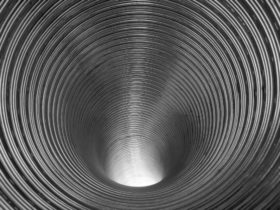The Dangers of Chimney Creosote
Has your chimney been inspected this fall? If you have a wood-burning appliance, you likely know the importance of having your chimney swept and inspected every fall before you light a fire, to ward off a potential chimney fire. You also might have heard the term “creosote” bandied about by your sweep or in reference to chimney fires. But what exactly is creosote? How does it form? And why is it so dangerous?
What is creosote?
Creosote is a natural byproduct of burning wood. It’s a tar-like substance that sticks to the walls of your chimney and builds up over time. Creosote can be sticky and brown or smooth and black.
How does creosote form?
Every time you burn a wood fire in your fireplace, creosote builds up on the walls of your chimney. As smoke travels up your chimney, it cools, and condensation forms on the walls of your chimney. That condensation contains all of the chemical elements put off by your wood fire. As your chimney continues to cool, the condensation hardens into creosote.
Why is creosote so dangerous?
The No. 1 danger associated with creosote is chimney fire. Creosote is highly combustible, and when it builds up to a measurable degree within your chimney, it poses a major fire risk. Creosote caked on the walls of your chimney can ignite either when the temperature within your chimney spikes to high enough temperature, or when a stray ember from the fireplace makes its way into the chimney. Ultimately, creosote is considered the primary risk factor for a chimney fire.
Creosote does come with some health risk factors, as well, but because the average homeowner using a wood-burning fireplace doesn’t come into contact with creosote, the health dangers of creosote are generally negligible for those who aren’t handling it. Creosote can irritate eyes and skin upon contact, or it can aggravate the lungs if inhaled. Ingesting creosote can cause stomach pain or even liver or kidney damage.
How can you reduce the dangers of creosote?
You probably know that the best way to reduce the dangers of creosote, namely the dangers of a chimney fire, is to have your chimney swept and inspected regularly. As those in the chimney industry are fond of saying, “Clean chimneys don’t catch fire!” In between sweepings, you can reduce creosote buildup in your chimney by burning dry, seasoned firewood. Seasoned firewood burns hotter and more cleanly, while wet firewood lets of more smoke and steam, leading to a more rapid buildup of creosote in the chimney.
Keep your home safe from the dangers of creosote by having your chimney swept and inspect before you burn a fire this fall! If you’re due for a chimney sweeping, call Your Chimney Sweep to schedule an appointment today!

 home safe from the dangers of a chimney liner. Fortunately, when it comes to chimney liners, there’s a safe, durable and easy-to-install option that’s right for nearly ever chimney: the stainless steel
home safe from the dangers of a chimney liner. Fortunately, when it comes to chimney liners, there’s a safe, durable and easy-to-install option that’s right for nearly ever chimney: the stainless steel